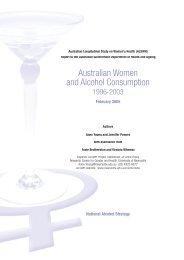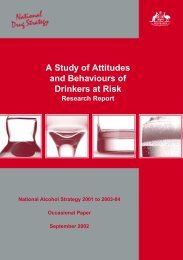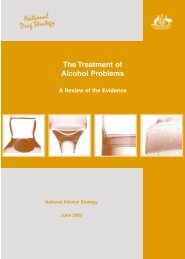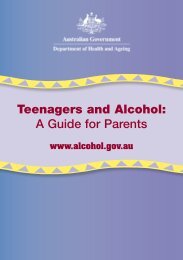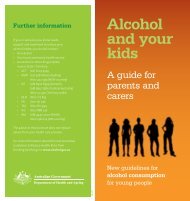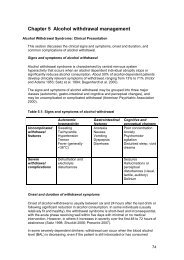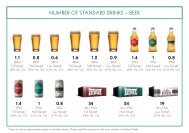Assessing dependence <strong>and</strong> alcohol-related harmsWhen assessing the patient’s dependence on alcohol <strong>and</strong> the related harms he/shemay be consequently suffering, clinicians should examine patient’s severity ofdependence, the consequences of drinking <strong>and</strong> any previous experiences ofabstinence <strong>and</strong> <strong>treatment</strong>.Severity of dependenceDSM-IV criteria or ICD-10 diagnoses are more often currently used to define alcoholdependence than the older questionnaires (American Psychiatric Association 2000;World Health Organization 1992).A number of instruments are available to assess the severity of alcohol dependence.However there is little current research on some of the questionnaires describedbelow.The Severity of <strong>Alcohol</strong> Dependence Questionnaire (SADQ-C) is most useful as an<strong>assessment</strong> tool with problem drinkers rather than as a screening tool (Stockwell etal. 1994). It takes about five minutes to complete <strong>and</strong> has five subscales: physicalwithdrawal symptoms, affective withdrawal symptoms, craving <strong>and</strong> withdrawal reliefdrinking, consumption <strong>and</strong> reinstatement. An addition, the Impaired Control Scale(ICQ) part of SADQ assesses the extent to which subjects perceive themselves to beout of control with respect to their alcohol use (Marsh et al. 2002).The original SADQ had good concordance with clinician ratings of alcoholdependence (Stockwell et al. 1979), high test-retest reliability, <strong>and</strong> significantcorrelations with observed withdrawal severity <strong>and</strong> narrowing of drinking repertoire(Stockwell et al. 1983) A cut-off score of 30 was found to indicate severedependence. However, a lower cut-off score may be appropriate for females due tothe contribution of consumption questions to the total score. The shortened version ofthe SADQ (SADQ-C) demonstrated good reliability <strong>and</strong> validity in a general(Australian) population sample (Stockwell et al. 1994). A key difference between theSADQ <strong>and</strong> the SADQ-C is that the latter focuses on the last three months, ratherthan a ‘recent period’ of heavy drinking.The Short <strong>Alcohol</strong> Dependence Data Questionnaire (SADD), a 15-itemquestionnaire, is similar to the SADQ, although less focused on the experience ofwithdrawal symptoms. The SADD <strong>and</strong> the SADQ are thought to measure the sametheoretical construct, i.e. the alcohol dependence syndrome (Raistrick et al. 1983;Heather 1995).The Severity of Dependence Scale (SDS) was the subject of a recent Australianstudy aiming to determine a cut-off point that discriminated between the presence<strong>and</strong> absence of a DSM-IV diagnosis of alcohol dependence. It was found that a scoreof 3 or above on the SDS was the optimal cut-off to detect alcohol dependence(Lawrinson et al. 2007).The <strong>Alcohol</strong> Dependence Scale (ADS), a 25-item questionnaire, is designed toidentify <strong>and</strong> assess alcohol abuse <strong>and</strong> dependence. It assesses four aspects of thealcohol dependence syndrome: loss of behavioural control, psychoperceptualwithdrawal symptoms, psychophysical withdrawal symptoms <strong>and</strong> obsessive-30
compulsive drinking style. The validation study for the ADS reported high correlationswith daily consumption of alcohol, lifetime use of alcohol, social consequences fromdrinking, prior <strong>treatment</strong> for alcohol abuse, use of alcohol to change mood, feelings ofguilt over drinking, <strong>and</strong> MAST scores (Skinner <strong>and</strong> Holm 1984). For alcohol usedisorders, a cut-off score of six or seven had a sensitivity of 0.97 <strong>and</strong> 0.75 specificity.An early study found high correlations between the ADS <strong>and</strong> the MAST, with an ADSscore of eight or nine accurately classifying 88 percent of patients with an alcohol usedisorder (Ross et al. 1990). The ADS was also found to correlate well with astructured diagnostic interview amongst a sample of homeless women(Chantarujikapong et al. 1997).A more recent study identified nine of the 25 ADS items as reliably discriminatingbetween those with no or minimal alcohol problems <strong>and</strong> those with symptoms ofexcessive or abusive drinking, in a sample of high-risk drinkers m<strong>and</strong>ated to adomestic violence program (Kahler et al. 2003). However, another study evaluatedthe concurrent validity of the ADS as a general measure of severity <strong>and</strong> thescreening accuracy of the total score <strong>and</strong> subscales to detect DSM-IV physiologicaldependence, with patients entering the COMBINE study. These authors concludethat the ADS reflected variation in symptom severity, but did not adequately identifyphysiological dependence or withdrawal in <strong>treatment</strong>-seeking individuals with DSM-IV alcohol dependence (Saxon et al. 2007).Consequences of drinkingThe clinician should assess the range of problems the patient has encountered as aresult of their drinking. In addition to physical <strong>and</strong> mental health, the patient’s drinkingmay have led to family problems, detrimentally affected work performance, socialrelations or financial stability. <strong>Alcohol</strong>-related offences such as drink–driving are alsorelevant. A specific crisis in one of these areas may have been the impetus forseeking help, <strong>and</strong> this should be explored. Discussion of the ‘less good things’ aboutdrinking can enhance the patient’s readiness for change. <strong>Alcohol</strong> harms are usuallyassessed using unstructured clinical interviewing.The <strong>Alcohol</strong> Problems Questionnaire (APQ) is a reliable instrument that covers eightdomains: friends, money, police, physical, affective, marital, children <strong>and</strong> work(Drummond 1990).Previous experiences of abstinence <strong>and</strong> <strong>treatment</strong>Previous episodes of abstinence or reduced drinking <strong>and</strong> <strong>treatment</strong> exposure areimportant to record <strong>and</strong> underst<strong>and</strong> as it helps to plan future <strong>treatment</strong>, both in termsof what worked <strong>and</strong> what did not, as well as to clarify patient experiences, tolerances.Recommendation3.13 Assessment of the patient’s alcohol-relatedproblems, diagnosis <strong>and</strong> severity of dependenceshould be recorded.Strength ofrecommendationSLevel ofevidenceAssessing physical well-being31
- Page 5 and 6: The third question of the AUDIT tak
- Page 7 and 8: Two screening instruments - TWEAK a
- Page 9 and 10: CDT and GGT are used in some clinic
- Page 11 and 12: instruments may be useful in select
- Page 13: theory has been tested widely, most
- Page 17 and 18: A limited range of measures of ment
- Page 19 and 20: education, ethnic background, langu
- Page 21 and 22: Assessing riskFull risk assessment
- Page 23 and 24: expressed preference for moderation
- Page 25 and 26: ReferencesAertgeerts, B, Buntinx F,
- Page 27 and 28: Dawe, S, Loxton N, Hides L et al. 2
- Page 29 and 30: Kurlowicz, L and M Wallace 1999, Th
- Page 31 and 32: Proude, E, Britt H, Valenti L et al
- Page 33 and 34: Stockwell, T, Hodgson R, Edwards G



